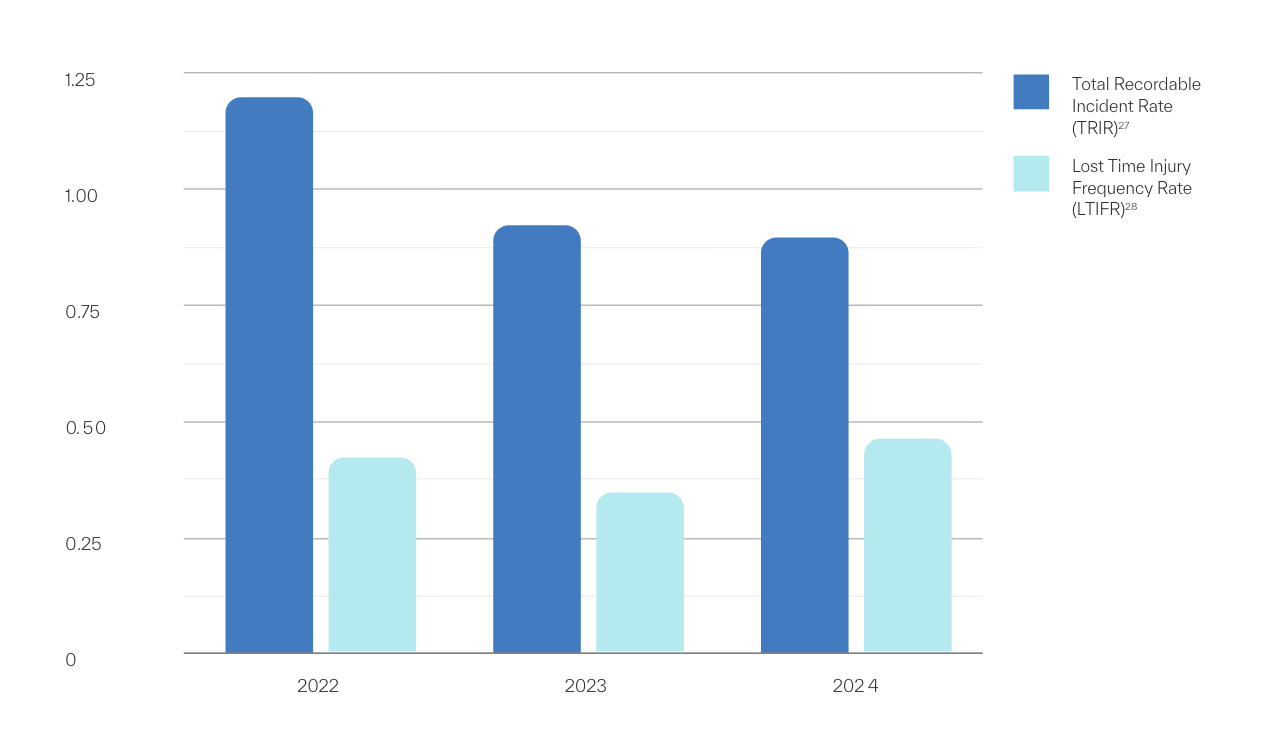Health & Safety

Our associates are our greatest asset and we want to ensure we are respecfful, nurturing and prioritizing safety. Health & Safety (H&S) has been identified as one of our three corporate values. Strong safety and health processes are essential to our business.
Our Environmental, Health & Safety (EHS) team oversees our H&S strategy by conducting audits of our operations, addressing remediation issues at our sites and assuring overall safety compliance. EHS efforts are divided between our two business units: Microbial Control Solutions (MCS) and Nutrition, Care and Environmental (NCE). Our MCS business unit has a shared EHS approach that is supported by our newly forged corporate EHS organization, transcending business unit boundaries to leverage best practices. To ensure that our H&S efforts are fully implemented at our individual facilities, the corporate EHS team, together with operations, is supported by dedicated personnel at the site level. These teams report to our group operations function and are primarily responsible for managing day-to-day H&S activities at our sites and facilities. By establishing clear lines of responsibility and oversight at both the corporate and business unit levels, we are effectively managing and promoting a H&S culture throughout our organization, positioning us to achieve our global H&S goals.
By 2030, we aim to achieve:

Safer together at Arxada
Our Safer Together at Arxada initiative reaffirms and further integrates the H&S culture at Arxada. Led by our corporate EHS team, Safer Together at Arxada focuses on our core values of Safety and Health, Ethical Behavior and Respect for People and Planet. The program aims to engage all associates to work collaboratively and foster new leadership behaviors in safety. It also acts as a key driver for our 2030 H&S goal. Safer Together at Arxada emphasizes the importance of bringing people together locally and globally, encouraging the collaboration and sharing of learnings and best practices.
In 2024, we strengthened our focus on the Life Saving Rules by enhancing our Serious Injury and Fatality (SIF) inspections. We implemented targeted inspection checklists that focus on compliance with each Life Saving Rule. The findings have been used to identify trends, improve training, and enhance our safety systems across the organization.
We also expanded the visibility of our Life Saving Rules by engaging with the communications team to create new posters, Teams backgrounds and templates for easy translation across the organization.
Digital signage was introduced in 2024 across the company to enhance associate engagement and communication. These digital displays, strategically placed in communal areas, provide real-time updates on safety performance and incidents, ensuring that all associates are well informed. By highlighting achievements and safety reminders, the signage fosters a culture of transparency and continuous improvement. This initiative underscores Arxada's commitment to maintaining a safe and informed workplace for everyone.
Arxada life saving rules
As part of efforts to implement Safer Together across Arxada, we also revised and entirely reshaped our policies and procedures landscape to better give clear and hands-on guidance on how to achieve best- in-class safety results. This new landscape is now split into high-level standards, mandatory procedures and supporting step-by-step guidance documents fully aligned and built on our non-negotiable Life Saving Rules. This step ensures strong support for our purpose of using better science to solve the world's toughest preservation challenges.
In 2024, we introduced a series of global procedures and policies designed to close identified gaps and further align our operations with our Life Saving Rules and high-level safety standards. These updates ensure that every site has the tools and direction needed to achieve best-in-class safety performance. The new procedures and policies were formally introduced during our monthly EHS and Site Managers Meeting, ensuring that leadership at every level is informed, aligned, and equipped to support implementation at their respective sites. This initiative reinforces our commitment to a unified, proactive safety culture—one that empowers every team member to work safely and confidently, no matter where they are in the world. Together, we are building a stronger, safer Arxada—one policy, one procedure, and one action at a time.
Creating a Health & Safety culture
We want our associates to understand the importance of H&S and live our Safety and Health values in their everyday actions. To help embed H&S into all we do, our associates on all levels have an annual H&S performance goal tailored to their specific role that reflects their contribution to Arxada's overall H&S performance. All Arxada associates are required to complete H&S training, including all relevant standard operating procedures for the processes they perform. For example, office-based and sales associates may be required to receive training on topics such as our policy for using phones when driving, while those who work with chemicals receive training on safe handling. In addition, all associates must complete H&S refresher training on an annual basis and take part in regular emergency response drills specific to each location. By providing tailored training to our associates, we are ensuring that they are equipped with the knowledge and skills needed to work safely and effectively, no matter the role.
In 2024, we saw an increase of 13.5% in our H&S related engagements made available to our associates. We ramped up our H&S related engagements from 74,593 in 2023 to 84,682 in 2024. We also wanted a clear focus on leadership engagements. The purpose of the leadership engagement is to focus on site leaders (managers and supervisors) initiating open dialogue and discussion with associates and contractors on a specific health and safety topic. In 2024, we completed 22,728 leadership-driven engagements.
To further prioritize safety throughout our company, in 2023 we launched comprehensive SIF prevention inspections. These inspections identify SIF precursors, such as high-risk activities or equipment malfunctions, and assist with implementing proactive injury mitigation measures. SIF prevention inspections are carried out by a team of trained associates who thoroughly observe and evaluate the conditions, equipment, procedures, and associate practices. The team evaluates 18 key risk areas, including Lock Out/Tag Out, loss of primary containment and other safety controls, using a customized checklist. In 2024, we completed 2,817 SIF prevention inspections compared with 502 in 2022 and 1,994 in 2023.
Management & auditing of sites
The corporate EHS team is responsible for regular audits of every Arxada facility to ensure that site-level EHS practices comply with regional laws and our own policies. Our audits allow us to better mitigate EHS-related risks and to ensure standardized H&S practices globally.
In addition to following regulatory auditing requirements, we follow a risk-based auditing system, grouping our sites into categories that determine the frequency of their auditing. At a minimum, every site is audited every three years.
During audits, we assess our sites based on their risk management systems and performance and their compliance with a range of EHS-related issues, including H&S measures, emergency preparedness and response, and the handling, storage and disposal of waste. We also conduct assessments for industrial hygiene and personal protective equipment.
When Arxada acquires a new facility, we conduct a separate EHS gap assessment in addition to our regular auditing process. This assessment is designed to identify areas where current practices may need to be improved or established to meet our standards. After completing the assessment, our EHS teams work with the evaluated sites to discuss the findings and develop an action roadmap for the next 12 to 18 months to address any identified weaknesses. By proactively identifying and addressing potential EHS issues, we are ensuring that all our sites operate in a safe, compliant and sustainable manner.
One hundred percent of our operational sites have conducted associate H&S risk assessments, which evaluate potential workplace hazards and how to minimize the impacts. These assessments are routinely updated to reflect the latest regulations and industry standards and consider any audit findings or other safety events including near misses.
Our Health & Safety performance
In 2023, we improved our H&S performance, with our Total Recordable Incident Rate (TRIR) and Lost Time Injury frequency rate (LTIFR) decreasing by 0.34 and 0.03 respectively. Read more about our Safer Together at Arxada program and our efforts to identify root causes of H&S incidents to prevent recurrence below. In 2024, we decreased our Total Recordable Incident Rate by 0.09. The LTIFR increased from 0.38 to 0.46, while the absolute number of lost time injuries remained unchanged. This reflects a lower total number of total workhours during the reporting period, which affects the frequency rate calculation. We remain fully committed to maintaining a safe workplace and continuously improving our safety performance.

Events & incidents
While we are working hard to maintain a rigorous and comprehensive H&S culture, incidents can happen. When they do occur, we learn and adapt to prevent reoccurrences. We utilize two specific approaches:
1. Root cause analysis: Using the definitions of the Center for Chemical Process Safety for leading and lagging process safety metrics, we require a thorough and detailed root cause analysis for every registered Tier 1 and 2 incident.³⁰,³¹
Through root cause analysis, we can identify why an accident occurred and implement measures to prevent it from occurring again. This approach has been in place at our legacy sites for some time. We have been working to align this methodology across all our global operations, offering training in EMEA, APAC and the Americas. To broaden the reach and effectiveness, the analysis and cause mapping are shared with all EHS and site managers during a monthly global call. This allows us to implement our learnings on a global scale.
2. SIF program: As part of our Safer Together at Arxada program, we implemented a SIF program and integrated this into our corporate H&S processes. As part of this, SIF training was carried out at manufacturing sites globally, and we are committed to thoroughly investigating all registered incidents and examining their potential to cause acute injury or fatalities. By actively engaging our associates and managers in this process, we aim to identify and eliminate any potential sources of serious harm in our operations.
Looking forward to 2025
In 2025, we will continue our efforts in improving process safety by establishing risk profiles for each manufacturing site. This risk profile will initiate an overview of high hazard sites and processes and determine the site level risk to introduce stronger critical controls. With transfer of materials being the leading cause of our process safety incidents, we are focused on addressing these issues using the hierarchy of controls, completing field audits of safety critical operating documents, standardizing preparation and execution of PHAs, and creating a process safety information sharepoint site for process owners.
[27] An injury or illness is considered a recordable incident if it results in any of the following: death, days away from work, restricted work or transfer to another job, medical treatment beyond first aid, or loss of consciousness. Additionally, a significant injury or illness diagnosed by a physician or other licensed healthcare professional is considered a recordable incident, even if it does not result in death, days away from work, restricted work or job transfer, medical treatment beyond first aid, or loss of consciousness.
[28] Rates are calculated as the number of injuries in the reporting period x 200,000 / Total hours worked in the reporting period.
[29] Leading metrics are a forward-looking set of metrics that indicate the performance of the key work processes, operating discipline, or protection layers that help prevent potential incidents. Lagging metrics are a retrospective set of metrics based on incidents that meet an established threshold of severity.
[30] Tier 1 incidents are described as catastrophic and exceed a defined threshold level, whereas a Tier 2 incident is used to normalize the industry metrics and provide a minimum and upper limit threshold range.


